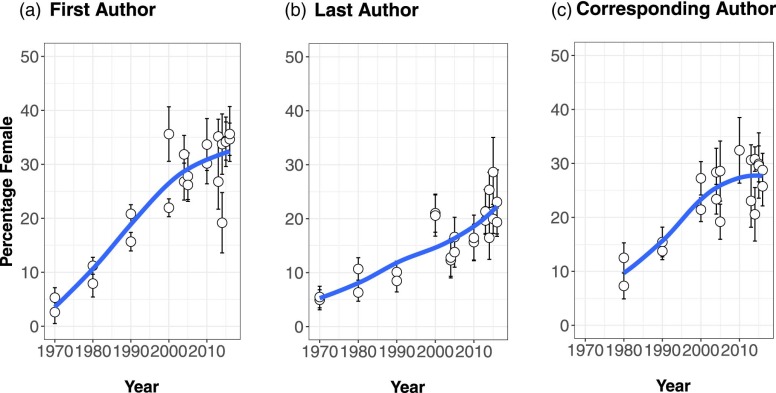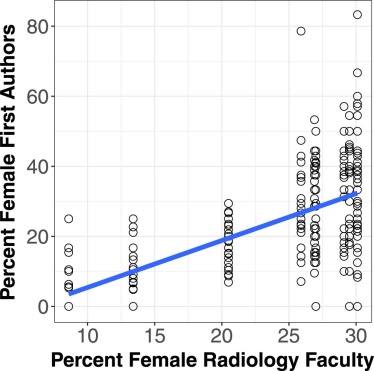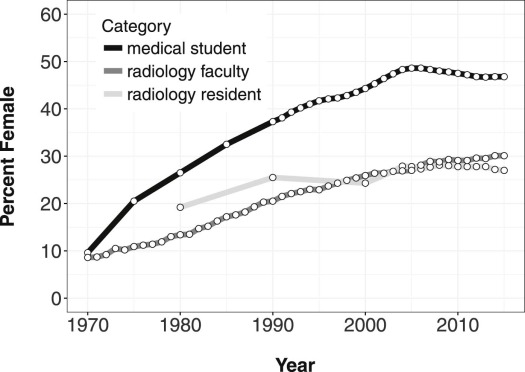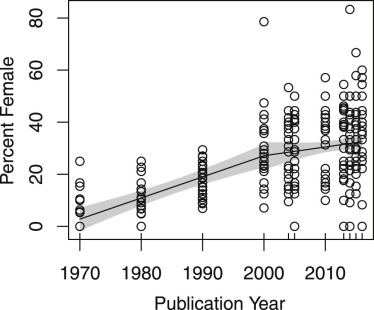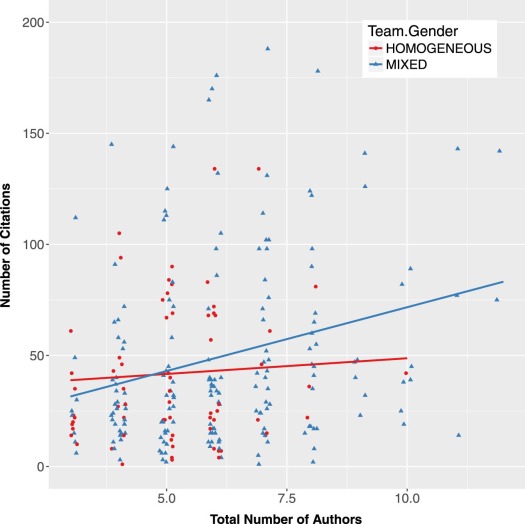Rationale and Objectives
Although substantial increases in publications by female academic radiologists have appeared over the last several decades, it is possible that the rate of increase is decreasing. We examined temporal trends in gender composition for full-time radiology faculty, radiology residents, and medical students over a 46-year period.
Methods
We examined authorship gender trends to determine if the increases in female authorship seen since 1970 have been sustained in recent years and whether female radiologists continue to publish in proportion to their numbers in academic departments. Original articles for selected years in Radiology and in the American Journal of Roentgenology between 1970 and 2016 were examined to determine the gender of first, corresponding, and last authors. Generalized linear models evaluated (1) changes in proportions of female authorship over time and (2) associations between proportions of female authorship and female radiology faculty representation.
Results
While linear increases in first, corresponding, and senior authorships were observed for female radiologists from 1970 to 2000, the rate of increase in female first and corresponding authorships then changed, with the slope of the first author relationship decreasing from 0.81 to 0.34, corresponding to 47% fewer female first authors added per year. In contrast, the proportion of female last authorship continued to increase at the same rate. The proportion of female first authorship was linearly related to the proportion of female radiology faculty from 1970 to 2016.
Conclusions
Annual increases in first author academic productivity of female radiologists have lessened in the past 16 years, possibly related to reductions in the growth of female radiology faculty and trainees. As mixed, compared to homogeneous gender, authorship teams are associated with more citations, efforts to encourage more women to pursue careers in academic radiology could benefit the radiology research community.
Background
Academic radiology has experienced increases in both absolute number and relative proportion of female radiology faculty and residents over the past several decades. In addition, a recent study exploring the effects of gender diversity on research productivity found that gender-heterogeneous working groups can produce higher-quality science, as evidenced by higher numbers of citations . This result underscores the importance of continuing to strive for gender parity in radiology departments. Although the increased female representation in radiology departments seems promising with respect to research quality, women still remain underrepresented at the associate professor and professor ranks and in upperlevel radiology department administration ( https://www.aamc.org/members/gwims/statistics/ ). Authorship can profoundly influence career trajectory in academic radiology. Moreover, academic productivity can profoundly influence decisions regarding faculty recruitment, hiring, and promotion . In addition, recent evidence suggests that salary determinations for medical school faculty can be influenced by publication productivity .
Publication of original research in peer-reviewed scientific journals is an important objective measure of academic productivity . Author placement also has implications for accountability and allocation of credit and can be used in determining worthiness for promotion, allocated research time, and research funding . With the exception of a minority of journals that list authors alphabetically, most journals list authors according to the author-rated level of contribution . The designation of first author is important because first authors generally make substantial contributions to every element of the research except provision of resources . Many studies are known by the name of their first author, lending credence to the idea that the first author plays an instrumental role in performing the work and in writing the manuscript .
Get Radiology Tree app to read full this article<
Get Radiology Tree app to read full this article<
Methods
Get Radiology Tree app to read full this article<
Get Radiology Tree app to read full this article<
Get Radiology Tree app to read full this article<
Statistical Methods
Get Radiology Tree app to read full this article<
Get Radiology Tree app to read full this article<
Get Radiology Tree app to read full this article<
Get Radiology Tree app to read full this article<
Get Radiology Tree app to read full this article<
Get Radiology Tree app to read full this article<
Results
Female Authorship Changes with Time
Get Radiology Tree app to read full this article<
Get Radiology Tree app to read full this article<
who held either an MD or an equivalent degree, were identified in the journal Radiology. First authors also served as the corresponding author in 65.7% of the Radiology articles examined and last authors served as corresponding authors in 20.9% of the articles examined. For the selected years during the 46-year period studied, a total of 1811 first authors, 1673 last authors, and 1818 corresponding authors were identified from AJR . First authors also served as the corresponding author in 69.2% of the AJR articles examined and last authors served as corresponding authors 16.7% of the time. Overall, gender was determined for 99% of the listed authors. For the sampled years over the 46-year time period, 23.5% of the first authors were female, 22.2% of the corresponding authors were female, and 15.2% of the last authors were female.
Get Radiology Tree app to read full this article<
Get Radiology Tree app to read full this article<
Get Radiology Tree app to read full this article<
Rate Change in Female Authorship with Time
Get Radiology Tree app to read full this article<
Get Radiology Tree app to read full this article<
Female Workforce Proportions Over Time
Get Radiology Tree app to read full this article<
Get Radiology Tree app to read full this article<
Female Authorship Proportion Association with Female Faculty Proportion
Get Radiology Tree app to read full this article<
Get Radiology Tree app to read full this article<
Authorship Team Gender Diversity Effects
Get Radiology Tree app to read full this article<
Get Radiology Tree app to read full this article<
Discussion
Get Radiology Tree app to read full this article<
Female Authorship Changes Over Time
Get Radiology Tree app to read full this article<
Get Radiology Tree app to read full this article<
Get Radiology Tree app to read full this article<
Get Radiology Tree app to read full this article<
Get Radiology Tree app to read full this article<
Get Radiology Tree app to read full this article<
Importance of Gender Diversity in Research Teams
Get Radiology Tree app to read full this article<
Get Radiology Tree app to read full this article<
Limitations
Get Radiology Tree app to read full this article<
Future Directions
Get Radiology Tree app to read full this article<
Conclusions
Get Radiology Tree app to read full this article<
References
1. Campbell L.G., Mehtani S., Dozier M.E., et. al.: Gender-heterogeneous working groups produce higher quality science. PLoS ONE 2013; 8: pp. e79147.
2. AAMC : The State of Women in Academic Medicine: The Pipeline and Pathways to Leadership, 2015–2016. https://www.aamc.org/members/gwims/statistics/ Accessed February, 2017
3. Choi M., Holliday E.B., Jagsi R., et. al.: Citation-based estimation of scholarly activity among domestic academic radiation oncologists: five-year update. J Radiat Oncol 2014; 3: pp. 115-122.
4. Jena A.B., Olenski A.R., Blumenthal D.M.: Sex differences in physician salary in US public medical schools. JAMA Intern Med 2016; 176: pp. 1294-1304.
5. Hirsch J.E.: Does the H index have predictive power?. Proc Natl Acad Sci USA 2007; 104: pp. 19193-19198.
6. Kaplan S.H., Sullivan L.M., Dukes K.A., et. al.: Sex differences in academic advancement. Results of a national study of pediatricians. N Engl J Med 1996; 335: pp. 1282-1289.
7. Baerlocher M.O., Newton M., Gautam T., et. al.: The meaning of author order in medical research. J Investig Med 2007; 55: pp. 174-180.
8. Shapiro D.W., Wenger N.S., Shapiro M.F.: The contributions of authors to multiauthored biomedical research papers. JAMA 1994; 271: pp. 438-442.
9. Riesenberg D., Lundberg G.D.: The order of authorship: who’s on first?. JAMA 1990; 264: pp. 1857.
10. Piper C.L., Scheel J.R., Lee C.I., et. al.: Gender trends in radiology authorship: a 35-year analysis. AJR Am J Roentgenol 2016; 206: pp. 3-7.
11. Liang T., Zhang C., Khara R.M., et. al.: Assessing the gap in female authorship in radiology: trends over the past two decades. J Am Coll Radiol 2015; 12: pp. 735-741.
12. Jagsi R., Guancial E.A., Worobey C.C., et. al.: The “gender gap” in authorship of academic medical literature—a 35-year perspective. N Engl J Med 2006; 355: pp. 281-287.
13. Ahmed A.A., Egleston B., Holliday E., et. al.: Gender trends in radiation oncology in the United States: a 30-year analysis. Int J Radiat Oncol Biol Phys 2014; 88: pp. 33-38.
14. Muggeo V.M.R.: Segmented: an R package to fit regression models with broken-line relationships. R News 2008; 8: pp. 20-25.
15. Long J.S.: Regression models for categorical and limited dependent variables.1997.SAGE PublicationsThousand Oaks, CA
16. Brotherton S.E., Etzel S.I.: Graduate medical education, 2005–2006. JAMA 2006; 296: pp. 1154-1169.
17. Brotherton S.E., Etzel S.I.: Graduate medical education, 2006–2007. JAMA 2007; 298: pp. 1081-1096.
18. Brotherton S.E., Etzel S.I.: Graduate medical education, 2007–2008. JAMA 2008; 300: pp. 1228-1243.
19. Brotherton S.E., Etzel S.I.: Graduate medical education, 2008–2009. JAMA 2009; 302: pp. 1357-1372.
20. Brotherton S.E., Etzel S.I.: Graduate medical education, 2009–2010. JAMA 2010; 304: pp. 1255-1270.
21. Brotherton S.E., Etzel S.I.: Graduate medical education, 2010–2011. JAMA 2011; 306: pp. 1015-1030.
22. Brotherton S.E., Etzel S.I.: Graduate medical education, 2011–2012. JAMA 2012; 308: pp. 2264-2279.
23. Brotherton S.E., Etzel S.I.: Graduate medical education, 2012–2013. JAMA 2013; 310: pp. 2328-2346.
24. Brotherton S.E., Etzel S.I.: Graduate medical education, 2013–2014. JAMA 2014; 312: pp. 2427-2445.
25. Brotherton S.E., Etzel S.I.: Graduate medical education, 2014–2015. JAMA 2015; 314: pp. 2436-2454.
26. Brotherton S.E., Etzel S.I.: Graduate medical education, 2015–2016. JAMA 2016; 316: pp. 2291-2310.
27. Brotherton S.E., Rockey P.H., Etzel S.I.: US graduate medical education, 2003–2004. JAMA 2004; 292: pp. 1032-1037.
28. AAMC : FAMOUS. https://services.aamc.org/famous/ Accessed February, 2017
29. R Core Team : R: A language and environment for statistical computing.2013.
30. Chapman C.H., Hwang W.T., Both S., et. al.: Current status of diversity by race, Hispanic ethnicity, and sex in diagnostic radiology. Radiology 2014; 270: pp. 232-240.
31. Lightfoote J.B., Deville C., Ma L.D., et. al.: Diversity, inclusion, and representation: it is time to act. J Am Coll Radiol 2016; 13: pp. 1421-1425.
32. Roubidoux M.A., Packer M.M., Applegate K.E., et. al.: Female medical students’ interest in radiology careers. J Am Coll Radiol 2009; 6: pp. 246-253.
33. Baker S.R., Barry M., Chaudhry H., et. al.: Women as radiologists: are there barriers to entry and advancement?. J Am Coll Radiol 2006; 3: pp. 131-134.
34. Forman H.P., Larson D.B., Kaye A.D., et. al.: Masters of radiology panel discussion: women in radiology—how can we encourage more women to join the field and become leaders?. AJR Am J Roentgenol 2012; 198: pp. 145-149.
35. Wenneras C., Wold A.: Nepotism and sexism in peer-review. Nature 1997; 387: pp. 341-343.
36. O’Connor E.E., Cousar M., Lentini J.A., et. al.: Efficacy of double-blind peer review in an imaging subspecialty journal. AJNR Am J Neuroradiol 2017; 38: pp. 230-235.
37. Nielsen M.W., Alegria S., Borjeson L., et. al.: Opinion: gender diversity leads to better science. Proc Natl Acad Sci USA 2017; 114: pp. 1740-1742.
38. Schiebinger L., Schraudner M.: Interdisciplinary approaches to achieving gendered innovations in science, medicine, and engineering. Interdiscip Sci Rev 2011; 36: pp. 154-167.
39. Jehn K.A., Northcraft G.B., Neale M.A.: Why differences make a difference: a field study of diversity, conflict, and performance in workgroups. Adm Sci Q 1999; 44: pp. 741-763.
40. Hong L., Page S.E.: Groups of diverse problem solvers can outperform groups of high-ability problem solvers. Proc Natl Acad Sci USA 2004; 101: pp. 16385-16389.
41. Amabile T., Khaire M.: Creativity and the Role of the Reader. Harvard Business Review2008.
